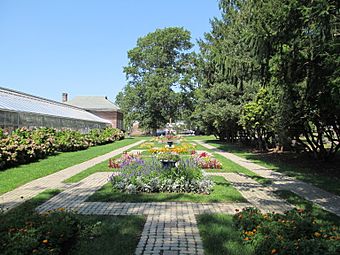Buttonwood Park Historic District facts for kids
Quick facts for kids |
|
|
Buttonwood Park Historic District
|
|

Formal Garden in Buttonwood Park
|
|
| Location | Bounded by Kempton St., Rockdale Ave., Hawthorne St., and Brownell Ave., New Bedford, Massachusetts |
|---|---|
| Area | 113 acres (46 ha) |
| Architect | Charles Eliot |
| Architectural style | Colonial Revival, Bungalow/Craftsman |
| NRHP reference No. | 00000915 |
| Added to NRHP | August 24, 2000 |
The Buttonwood Park Historic District is a special area in New Bedford, Massachusetts. It is found near Kempton Street, Rockdale Avenue, Hawthorne Street, and Brownell Avenue. This district is known for its history and unique buildings.
The most important part of this district is Buttonwood Park. This park covers about 97 acres (39 hectares). A famous landscape architect named Charles Eliot designed the park in the 1890s. The neighborhood around the park grew in the early 1900s. It has many beautiful houses built in the Colonial Revival and Craftsman styles. This historic district was added to the National Register of Historic Places in the year 2000. This means it is a place important to the history of the United States.
About Buttonwood Park and its History
Buttonwood Park is a public park located west of downtown New Bedford. It has a shape that looks a bit like the letter "L". The northern part of the park is covered with trees. A 7-acre (2.8-hectare) pond separates this wooded area from the rest of the park.
A road crosses over a dam at the southern edge of the pond. This road helps people move around the park. The southwestern part of the park is home to the Buttonwood Park Zoo. The southeastern area has open grassy spaces for relaxing. It also has sports fields for different activities. The park's design today is based on Charles Eliot's original plan from the 1890s. Some parts were changed over time.
The park is surrounded by four main roads. These are Brownell Avenue, Kempton Street, Rockdale Avenue, and Hawthorne Street. The area around the park has many streets with houses. These houses are usually made of wood. They were built in popular styles from the early 1900s.
You will often see houses in the Craftsman style. Many of these are the smaller "Bungalow" type. There are also many Colonial Revival style homes. Some older Queen Anne Victorian houses can be found too. The houses are built on small plots of land. They are generally set back a similar distance from the street. There is one church in the district. A few modern shops are also present.



